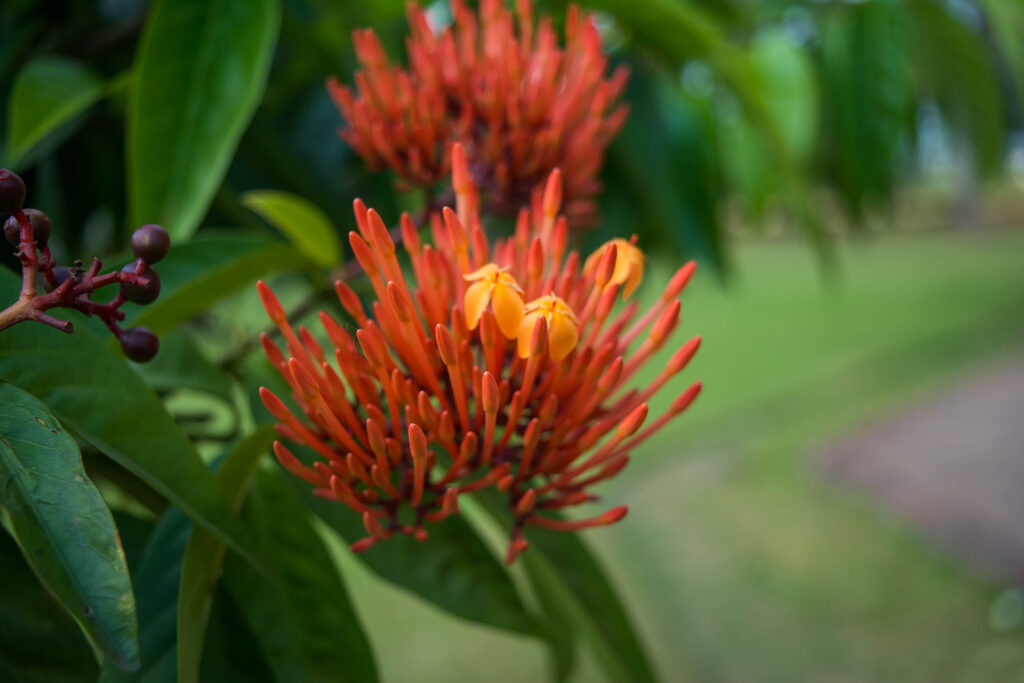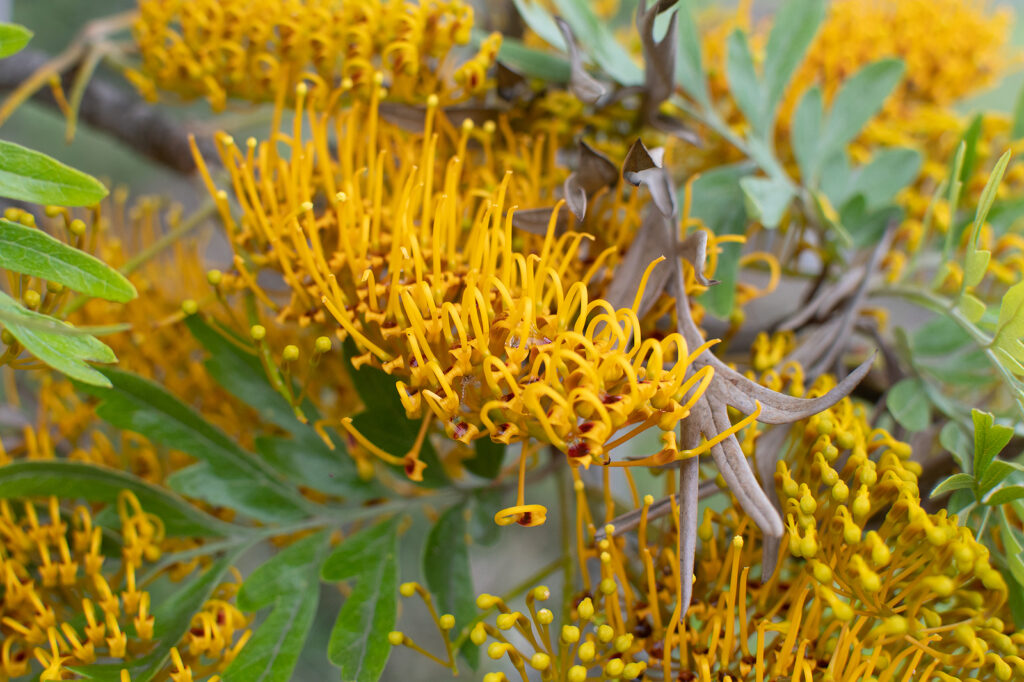Grevillea is a genus of evergreen shrubs and trees native to Australia. Grevillea bears showy clusters of slender tubular flowers that split and curve backward giving them a spidery look Flower colors vary by species, but red is often seen. The foliage is often fine and needlelike.
Grevilleas species and cultivars vary in size from small shrubs to tall, spreading trees. Larger species are useful as specimens against a wall, or in borders with other large shrubs. Smaller ones can be placed at the front of a border or in a rock garden.
Grevillea is a genus of at least 250 species of evergreen shrubs and trees. Grevillea are native to Australia. There are many named hybrids.

Get to know Grevillea
- Plant type: Evergreen shrubs or trees
- Growing zones and range: Zones 9 to 11
- Hardiness: Hardy to Zone 9; Grevillea thrives in the 50° to 60°F (10°-16°C) range
- Height and width: Plants vary in size and appearance; some as small ast 3 feet (1m) tall and 6 feet (2m) wide, others as large as 50 feet (15m) tall and as wide.
- Foliage: Fine-textured often needlelike leaves, some broader
- Flowers: Dense clusters of slender, tubular flowers that split and curve backward with long styles that give them a spidery appearance; flower colors include red, pink, purplish pink, orange, yellow, or cream.
- Bloom time: Spring to autumn
- Uses: Larger species are useful as specimens against a wall, or in borders with other large shrubs. Smaller ones can be used at the front of a border or in a rock garden.
- Common name: Grevillea
- Botanical name: Grevillea
- Family name: Proteaceae
- Origin: Australia
Where to plant Grevillea
- Plant Grevillea in full sun.
- Plant Grevillea in moderately fertile, neutral to acid soil.
- Grevillea tolerates drought and heat but not salt or high levels of phosphorus.
When to plant Grevillea
- Set Grevillia outdoors in the garden in spring or autumn.
Planting and spacing Grevillea
- Space Grevillea 6 feet (2m) to 15 feet (5m) apart or more depending on the variety.
How to water and feed Grevillea
- Grevillea grows best in just moist, but not wet soil. Mature plants can tolerate dry soil.
- Water Grevillea sparingly in winter.
- Grevillea is sensitive to high levels of phosphorus in the soil. Fertilize lightly; avoid fertilizers with high phosphorus content.
- Fertilize Grevillea with a low-phosphorus, liquid fertilizer monthly during the growing season.

Grevillea care
- Grevillea needs minimal pruning.
- Container-grown Grevillea is best transplanted every spring to a pot at least 2 inches (5cm) bigger than its previous pot to allow for vigorous growth. Use an all-purpose soil mix for repotting.
Growing Grevillea as a houseplant
- Grevillea robusta, silk oak tree, with fernlike foliage is often grown as a houseplant.
- Give Grevillea bright to direct light, a cool temperature, good air circulation, and medium to high humidity growing indoors.
- The soil should be allowed to dry slightly between thorough waterings.
- Fertilizer can be applied regularly during spring and summer.
Grevillea pests and diseases
- Grevillea can be attacked scale insects and mealybugs.
- Grevillea is somewhat prone to root rot and dieback.
Grevillea propagation
- Propagate from semihard cuttings in summer.
- Sow scarified or pre-soaked seed in warm soil in spring.

Grevillea varieties to grow
- Grevillea banksii. Red-flowered silky oak. Shrub or small tree. Grows 15 to 20 feet tall and nearly as wide. Leaves 4 to 10 inches long, deeply cut into narrow lobes. Bears erect, 3 to 6-inch-long clusters of dark red flowers sporadically through the year; bloom is heaviest in late spring. Freezes at 24°F (-4°C). Often sold as G. banksii forsteri.
- G. ‘Canberra’. Shrub. Open, graceful grows to 8 feet tall and 12 feet wide; bright green, needlelike, 1-inch leaves; clusters of red flowers in spring and intermittently at other times of year.
- G. ‘Constance’. Shrub. similar to ‘Canberra’ but broader in growth; orange-red flowers.
- G. lavandulacea. Lavender grevillea. Shrub. Size varies with cultivar: ‘Billywing’ grows 2 ½ feet high, 6 feet wide, with red-and-cream flowers in winter and spring. ‘Penola’ grows 5 feet tall or taller, 8 feet wide (wider if unpruned), with deep rose-red flowers. ‘Tanunda’ is 1 ½-3 feet tall, 3-6 feet wide, with profuse coral pink flowers; main bloom winter.
- G. ‘Noellii’. Shrub. Probably a hybrid. Grows to 4 feet tall and 4 to 5 feet wide. Dense glossy green leaves; clusters of pink-and-white flowers bloom in spring.
- G. robusta. Silk oak. Tree. Fast-growing to 60 feet (rarely 100 feet). Symmetrical, pyramidal form when young, broad topped when old usually with a few heavy, horizontal limbs. Fernlike leaves golden green to deep green above, silvery beneath; heavy leaf drop in spring, sporadic leaf drop through rest of year. Large clusters of bright golden-orange flowers in early spring. Wood is brittle, easily damaged in high wind. Young trees damaged at 24°F (-4°C); older ones hardy to 16°F (-9°C).
- G. rosmarinifolia. Compact shrub. Grows 5 to 6 feet tall and wide with linear leaves similar to rosemary; bears 3-inch racemes of red and cream (occasionally pink or white) flowers from autumn into early spring.















